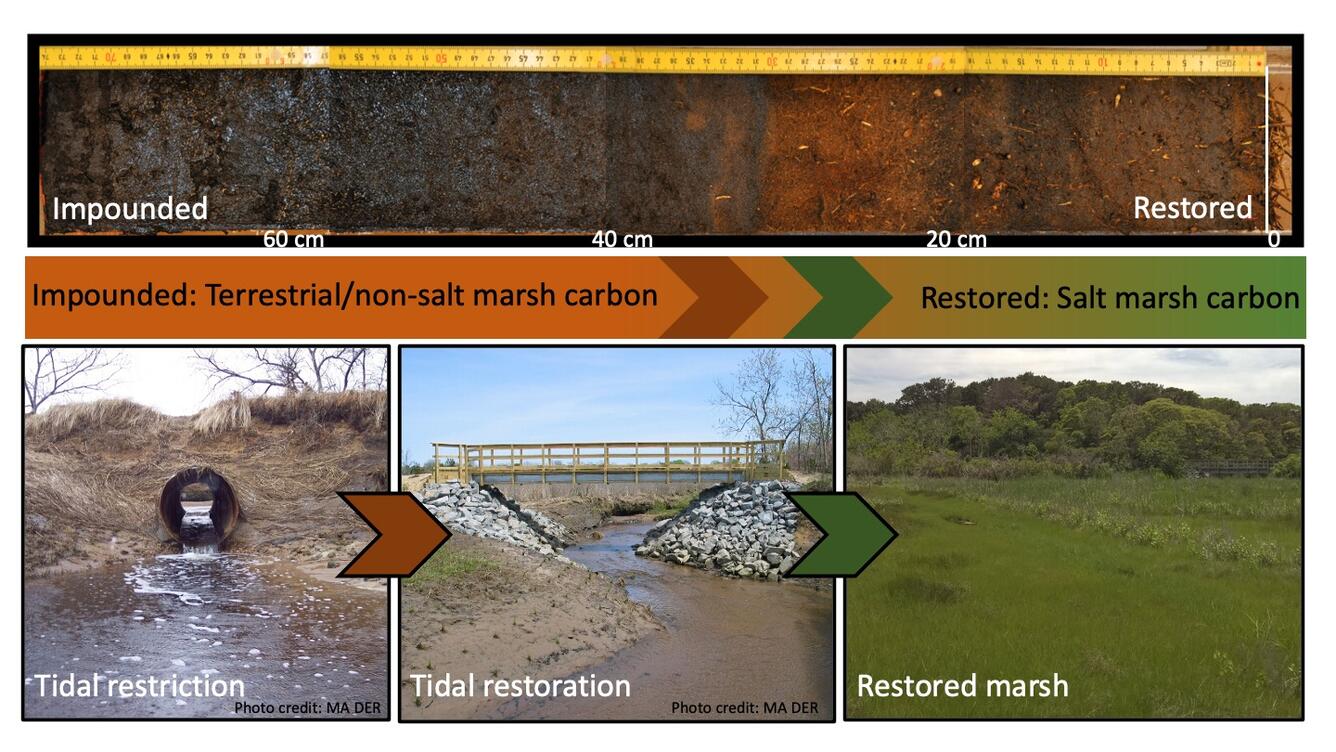A recent study shows that restoring tidal exchange in impounded coastal wetlands can enhance their elevation resilience and climate change mitigation benefits.
This article is part of the September-November 2022 issue of the Sound Waves newsletter.
Coastal wetlands are known for the numerous critical ecosystem services they provide to our society, such as helping to mitigate climate change by storing large quantities of atmospheric carbon in their soil and plants. However, when wetlands are drained or impounded due to human activities, it disrupts tidal exchange and alters the wetland’s hydrology, negatively affecting soil accretion and the overall elevation of the wetland—a real concern in the face of sea-level rise. When coastal wetland hydrology and soil accretion are negatively impacted, blue carbon storage capabilities are suppressed, causing substantial amounts of carbon and methane to be released into the atmosphere. Coastal wetland restoration is an important opportunity to restore the ecosystem’s natural carbon balance and maintain the wetland’s carbon sequestration and storage capabilities.
In a recent study, Dr. Meagan Eagle of the U.S. Geological Survey (USGS) and her research team provide evidence that restoring tidal exchange and optimizing conditions for vegetation growth in impounded coastal wetlands can enhance the ecosystem’s elevation resilience and climate change mitigation benefits.
The study had two goals: (1) assess the historical effects of hydrologic manipulation on subsidence (the sinking of the marsh surface and a lack of sediment being added to the marsh surface) and associated carbon capture and storage loss; and (2) determine the impact of restoring tidal exchange and hydrologic conditions on soil and carbon accretion to assess the climate change mitigation potential of restoring impounded wetlands. To achieve these goals, the research team compared five restored coastal wetlands that had previously experienced over a century of impounded hydrology, with natural salt marshes in the same area with no history of tidal impoundment. The five study sites were selected within a small geographic area on Cape Cod, Massachusetts. The sites included Quivett Creek, Bass Creek, Stony Brook, Boat Meadow, and Scusset (Scusset Creek and the natural analogue, Mill Creek). At each location, change over the past 100 years was assessed. The metrics evaluated include soil and carbon accretion rates, the source of soil organic matter, marsh surface elevation, porewater levels and salinity, and creek water levels and salinity.
Results show that impoundment suppressed elevation gain and blue carbon storage at the five sites, with rates 40% lower in impounded sites than in the natural coastal wetlands. Restoring hydrology significantly increased soil accretion and successfully induced elevation gains. Carbon storage also increased after restoration, although within 14 years post restoration, it had not reached the rates of the natural coastal wetlands.
Restoring tidal exchange in wetlands is beneficial to habitat, control of invasive species, and remediation of elevation loss; however, coastal wetland managers need more information on the climate change benefits of hydrologic restoration. This study provides a better understanding of additional metrics, including greenhouse gas cycling and carbon capture, needed to assess the impact of restoration on climate change mitigation. This knowledge can help advance blue carbon management as a natural climate solution—an emerging priority within U.S. and international climate policy.
The publication team included Dr. Meagan Eagle (USGS Woods Hole Coastal and Marine Science Center (WHCMSC)), Dr. Kevin Kroeger (WHCMSC), Dr. Amanda Spivak (Department of Marine Sciences, University of Georgia), Dr. Faming Wang (Marine Biological Laboratory (MBL) and Xiaoliang Research Station for Tropical Coastal Ecosystems, Key Laboratory of Vegetation Restoration and Management of Degraded Ecosystems, and the CAS Engineering Laboratory for Ecological Restoration of Island and Coastal Ecosystems, South China Botanical Garden, Chinese Academy of Sciences), Dr. Jianwu Tang (MBL), Dr. Omar Abul-Aziz (West Virginia University), Dr. Khandker Ishtiaq (West Virginia University and Institute of Environment, Florida International University), Jennifer O’Keefe Suttles (WHCMSC), and Adrian Mann (WHCMSC). The paper, “Soil carbon consequences of historic hydrologic impairment and recent restoration in coastal wetlands,” was published in the journal Science of The Total Environment on July 31, 2022.
Get Our News
These items are in the RSS feed format (Really Simple Syndication) based on categories such as topics, locations, and more. You can install an RSS reader browser extension, software, or use a third-party service to receive immediate news updates depending on the feed that you have added. If you click the feed links below, they may look strange because they are simply XML code. An RSS reader can easily read this code and push out a notification to you when something new is posted to our site.





